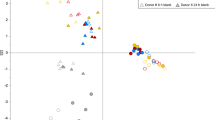Abstract
The prebiotic potential of oat samples was investigated by in vitro shaker-flask anaerobic fermentations with human fecal cultures. The oat bran fraction was obtained by debranning and was compared with other carbon sources such as whole oat flour, glucose, and fructo-oligosaccharide. The oat bran fraction showed a decrease in culturable anaerobes and clostridia and an increase in bifidobacteria and lactobacilli populations. A similar pattern was observed in fructo-oligosaccharide. Butyrate production was higher in oat bran compared to glucose and similar to that in fructo-oligosaccharide. Production of propionate was higher in the two oat media than in fructo-oligosaccharide and glucose, which can be used as energy source by the liver. This study suggests that the oat bran fraction obtained by debranning is digested by the gut ecosystem and increases the population of beneficial bacteria in the indigenous gut microbiota. This medium also provides an energy source preferred by colonocytes when it is metabolized by the gut flora.

Similar content being viewed by others
References
AACC (1995) Methods from American Association of Cereal Chemists: approved methods of the association, 9th edn. AACC, St. Paul, MN
Bradshaw J (2004) Debranning. Grain Feed Mill Tech July–August: 10–13
Bradshaw J (2005) Developments in semolina milling. Grain Feed Mill Tech July–August: 14–17
Caplice E, Fitzgerald GF (1999) Food fermentations: role of microorganisms in food production and preservation. Int J Food Microb 50:131–149
Cummings J (1984) Colonic absorption: the importance of short chain fatty acids in man. Scand J Gastroenterol 93:89–99
Cummings JH, Macfarlane GT (1991) Production and metabolism of short-chain fatty acids in humans. Presented at Tenth Ross Conferenece on Medical Research
Englyst H, Hay S, Macfarlane G (1987) Polysaccharide breakdown by mixed populations of human faecal bacteria. FEMS Microb Ecol 95:163–169
Gibson G, Roberfroid M (1995) Dietary modulation of the human colonic microbiota: introducing the concept of prebiotics. J Nutr 125:1401–1412
Handelman GJ, Cao G, Walter MF, Nightingale ZD, Paul GL, Prior RL (1999) Antioxidant capacity of oat (Avena sativa L.) extracts. Inhibition of low-density lipoprotein oxidation and oxygen radical absorbance capacity. J Agr Food Chem 47:4888–4893
Hobbie JE, Daley RJ, Jasper S (1977) Use of nucleopore filters for counting bacteria by fluorescence microscopy. Appl Environ Microbiol 33:1225–1228
Kedia G, Wang R, Patel H, Pandiella SS (2007) Use of mixed cultures for the fermentation of cereal-based substrates with potential probiotic properties. Proc Biochem 42:65–70
Kedia G, Vázquez JA, Pandiella SS (2008) Evaluation of the fermentability of oat fractions obtained by debranning using lactic acid bacteria. J Appl Microbiol 105:1227–1237
MacMasters MM, Hinton JJC, Bradbury D (1971) Microscopic structure and composition of the wheat kernel. In: Pomeranz Y (ed) Wheat: chemistry and technology. AACC, St. Paul, MN
Mandalari G, Nueno Palop C, Tuohy K, Gibson GR, Bennett RN, Waldron KW, Bisignano G, Narbad A, Faulds CB (2007) In vitro evaluation of the prebiotic activity of a pectic oligosaccharide-rich extract enzymatically derived from bergamot peel. Appl Microb Biotech 73:1173–1179
McCleary BV, Codd R (1991) Measurement of (1–3) (1–4) beta glucan in barley and oats: a streamlined enzymic procedure. J Sci Food Agr 55:303–312
Motulsky H (ed) (1995) Intuitive biostatistics. Oxford University Press, New York, pp 285–286
Palframan R, Gibson G, Rastall R (2003) Development of a quantitative tool for the comparison of the prebiotic effect of dietary oligosaccharides. Lett Appl Microb 37:281–284
Prosky L, Asp NG, Schweizer T, DeVries J, Furda I (1988) Determination of insoluble, soluble, and total dietary fibre in foods and food products: interlaboratory study. J Assoc Offic Anal Chem 71:1017–1023
Titgemeyer E, Bourquin L, Fahey G, Garleb K (1991) Fermentability of various fibre sources by human fecal bacteria in vitro. Am J Clin Nutr 53:1418–1424
Vernazza CL, Gibson GR, Rastall R (2005) In vitro fermentation of chitosan derivatives by mixed cultures of human faecal bacteria. Carbohydr Polym 60:539–545
Wang R (1999) Continuous production of a generic fermentation feedstock from whole wheat flour. Department of Chemical Engineering, UMIST, Manchester, UK
Wang R, Koutinas A, Campbell G (2007) Effect of pearling on dry processing of oats. J Food Eng 82:369–376
Author information
Authors and Affiliations
Corresponding author
Rights and permissions
About this article
Cite this article
Kedia, G., Vázquez, J.A., Charalampopoulos, D. et al. In Vitro Fermentation of Oat Bran Obtained by Debranning with a Mixed Culture of Human Fecal Bacteria. Curr Microbiol 58, 338–342 (2009). https://doi.org/10.1007/s00284-008-9335-1
Received:
Revised:
Accepted:
Published:
Issue Date:
DOI: https://doi.org/10.1007/s00284-008-9335-1




